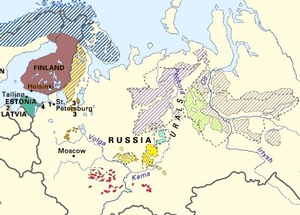The languages from which the word pelmeni appeared have importance in conjecturing the origin of its terminology. The Komi and Finno-Ugric languages form a group of the Finnic-languages with the Udmurt language. 16 languages are included into Finno-Ugric family, including Mansi. The majority of people speaking these languages live in western Siberia ("Traditional Russian Recipes"). Modern scientists, while studying the origin of Finno-Ugrians, came to the conclusion the homeland of the Finno-Ugrians was located in the on the both sides of Urals. In fact, the Russian word for noodles, lapsha, comes from Turkic instead of the Germanic nudel from which both the English noodle and the French nouille derive (Molokhovets 18). This has significance in not only determining the dumpling’s etymology, but also its point of origin. Other possible explanations for the name pelmeni could be the connection of the room men to the Chinese word mein, which means “wheat flour” (Mack 75). While this prediction of pelmeni’s etymology is far-fetched, many other noodle dishes and dumplings have the same root such as laghman, manti, and, manpar. This lends some credence to the claim that pelmeni may ultimately come from this root (Mack 75). Regardless, this root continues to mediate through the Finno-Ugric languages today.

